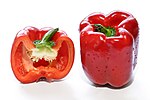Capsaicin (8-methyl-N-vanillyl-6-nonenamide) (/kæpˈseɪsɪn/ or /kæpˈseɪəsɪn/) is an active component of chili peppers, which are plants belonging to the...
59 KB (5,930 words) - 07:55, 18 October 2024
(SHU). It is based on the concentration of capsaicinoids, among which capsaicin is the predominant component. The scale is named after its creator, American...
27 KB (2,196 words) - 00:57, 19 October 2024
Chili pepper (section Capsaicin)
are widely used in many cuisines as a spice to add "heat" to dishes. Capsaicin and the related capsaicinoids give chili peppers their intensity when...
51 KB (4,960 words) - 08:42, 24 October 2024
poissonii found in northern Nigeria. It is a potent functional analog of capsaicin, the active ingredient in chili peppers. Resiniferatoxin has a score of...
13 KB (1,216 words) - 07:51, 18 October 2024
mustard and curry. The primary substances responsible for pungent taste are capsaicin, piperine (in peppers) and allyl isothiocyanate (in radish, mustard and...
10 KB (1,071 words) - 21:27, 14 October 2024
Pepper spray (redirect from Capsaicin spray)
capsicum spray, OC spray, capsaicin spray, or capsicum spray is a lachrymator (tear gas) product containing the compound capsaicin as the active ingredient...
70 KB (7,882 words) - 01:09, 13 October 2024
TRPV1 (redirect from Capsaicin receptor)
potential cation channel subfamily V member 1 (TRPV1), also known as the capsaicin receptor and the vanilloid receptor 1, is a protein that, in humans, is...
57 KB (6,738 words) - 07:29, 6 October 2024
several cross breedings that produced an exceptionally high content of capsaicin in the locules – the plant tissue holding the seeds. The extensive curves...
3 KB (309 words) - 12:52, 6 September 2024
nature (e.g., hydration). There is tentative evidence for the use of capsaicin cream on the abdomen during an acute episode. Of note, frequent hot showers...
37 KB (4,058 words) - 00:29, 2 November 2024







